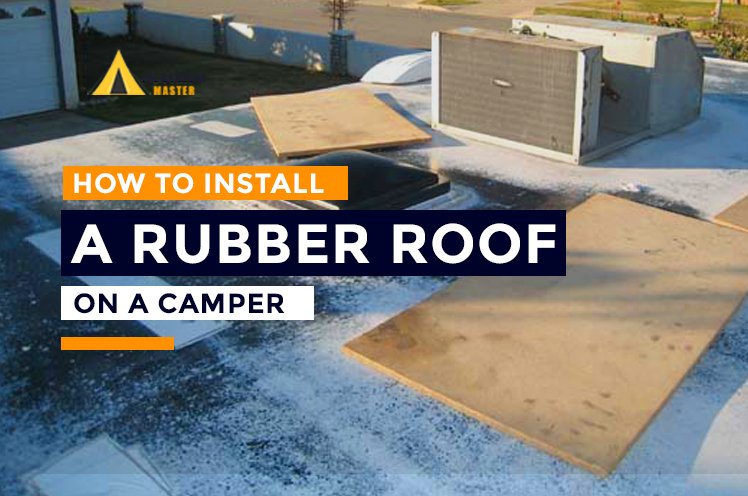How to install a rubber roof on a Camper? If you want to add a rubber roof to your camper, you must know several ways to make its installment perfect. Your RV’s roof protects you from a harsh environment, i.e., dust, sandstorm, rainstorm, etc. It is the most fundamental component of your RV. Therefore, it is imperative to have a high-quality rubber roof.
Installing a rubber roof is not easy and might be like a nightmare for you, as it is tiring and challenging, and you may need more than one assistant to fix it perfectly. Although it is time-consuming, you should not spend a whole day on it.
To know how to install a rubber roof on a camper, you have to follow specific steps which make you able to do this difficult and tiresome job easily without wasting money and time. With the help of an assistant and some below-mentioned tools and apparatus, and by following every step correctly, you will get your roof done quickly.
How to install a rubber roof on a Camper (Step-by-Step)
If you install the rubber roof for the first time on your camper, this step-by-step tutorial will help you a lot in every step and about everything you need to do the job quickly and perfectly. By reading this complete article, you will surely be able to finish this job in a few hours. And you will have a new and long-lasting roof for your recreational vehicle.
Tools and Material Needed:
How to install a rubber roof on a Camper for the process, you will need some equipment listed below
• Lap sealant
• Ladder
• Putty Knife
• Screwdriver
• Roof adhesive
• Rubber Roof
• Metal shears or saw (If you have a metal roof to remove).
How to install a rubber roof on a Camper? You may use an electrical sander for your convenience or may do this job manually. Although an electrical sander costs you much, you may keep yourself from various hours of monotonous hand sanding and scratch on a large camper. You can either borrow and also rent an electric sander for the purpose.
You don’t need shears if your recreational vehicle already has a rubber roof. The metal shears are only required when removing the metallic roof before installing the rubber roof.
Step 1: Removal of all hoods, vents & housings
Before doing anything, you must eliminate vents, housings, and vent hoods from your recreational vehicle’s roof. It is elementary to remove vents and housings. You have to do nothing but unscrew them with a ¼” head screwdriver, then use a putty knife to scour up the former lap sealant and lever open the vents or housing off the roof.
Step 2: Removal of strips, caps, and termination bars
After this, removing termination bars, strips, caps, and drip edges from the recreational vehicle’s roof is more necessary for the query of How to install a rubber roof on a Camper. You will have to use a putty knife to remove the lap sealant, which covers up the screws, then remove all the components by unscrewing them.
Remember that every RV uses a different component according to the model or design. Some RV has caps, some termination bars, etc. Before this step, you must inspect the roof and remove the components of your RV.
Step 3: Removal of an old roof
Finally, you are ready to remove the Old roof. If your old roof is rubber, not metallic, your work is relatively more straightforward. You can use a putty knife for scraping the roof.
But, if your roof is metallic, as some RV has. Remember to wear a protective costume before starting the process, as you must use metallic shears and saws. Wearing gloves on hand and an additional layer of clothes for your protection will ensure your safety.
Step 4: Cleaning the roof’s surface
After you have removed your old roof, you next have to clean up the surface where it was sited. This step is quite critical, especially when your old roof is metallic. Due to drilling and cutting during the removal of the old roof, some fragments and splinters were left behind.
You have to sand all the inconsistencies of the roof’s deck and use seems tape to fill up all the gaps in the seams. Sanding is essential because it creates an extra-smooth surface, which will ultimately be helpful in the adherence to the new rubber roof.
Now is when you can replace the plywood foundation of the roof if needed. You can also watch any video tutorial for tips.
Step 5: Adhering to the new roof
For now, this specific step needs assistance for you, as an extra pair of hands can be pretty helpful for better adherence to the new roof. The best way now is to complete a portion of your roof at a time.
You can initiate this step by placing the roll of the new rubber roof on the end of the top. You will adhere the roof in 4 feet sections until and unless the whole roof is done with adherence.
Now, use the paint roller to roll a layer of the adhesive on the roof’s deck covering the small region of about 4-feet section. Wait for a little until the glue becomes tacky,
now you can roll the replacement roof membrane onto the glue.
Smooth the membrane out. Remember to remove every air bubble between the membrane and plywood. Keep on doing until the entire roof is done with covering. Now cut the extra roofing material with any utility knife’s help.
Step 6: Cutting of holes for vents, hoods & housings
When you have laid the new roof, it is your turn to cut out the holes for the vents, housings, and vents’ hood, which you have on the roof of your camper. It is pretty easy to do with the help of a utility knife. Cut the X-shape holes so you can fold the flaps in the opening and then screw them down.
Step 7: Reinstall roof components
Finally, you must install the drip edges, caps, strips, termination bars, and vents. When everything is done and you have placed well. You can use the utility knife to cut the extra roofing off from the sides. Then cover all the naked joints, seams, and screws using the lap sealant, and you are done!
Final Thoughts
How to install a rubber roof on a Camper? It was the question of the day! Although installing a rubber roof in your camper is difficult, you can do it easily in a short time if you have the right path to follow.
You, in this article, went through a step-by-step tutorial on this topic. Remember that you are not skipping any steps to get the desired results. And also every step correctly without getting panicked.
I hope the article on how to install a rubber roof on a camper was quite helpful for you. How helpful was it, how much did you learn from it, and what is missing in this article? You can let me know about it in the comment section below.
FAQs regarding How to install a rubber roof on a Camper
1. What is the cost of replacing the rubber roof on the RV?
Answer: The cost of the RV rubber roof can vary from manufacturer to manufacturer. A website, vehq.com, has estimated the average overall worth of the replacement rubber roof for RVs. the estimated cost is between $300 and $325 per foot. The cost of repairing and installment depends upon different factors like; whether you are hiring anyone or doing it by yourself.
2. Which RV roof is better, EPDM or TPO?
Answer: There are two common types of RV roofs; To know which one is better, you should know about the pros and cons of them both and should weigh them against each other. Following is a deep synopsis of both for finding the best roofing material for your RV.
TPO
TPO is the abbreviation of Thermoplastic Polyolefin; you can prefer it for two main reasons; the first one is it is affordable, and the second one is it is already colored in white color.
Another advantage of TPO is its durability. As compared to other types of thermoplastic membranes, TPO is mold resistant and also dustproof. TPO is also resistant to brunt and scratch.
But the negative aspect of TPO does not charge enough with the high heat. The TPO roof experiences accelerated weathering if it is in the open in the high heat.
EPDM
EPDM, which is the abbreviation of Ethylene Propylene Diene Monomer, is also a popular type of RV roofing that you can use. It is prevalent because it is constructed from a mixture of saw dust and slate dust, the automotive tires.
It is made up of recycled material tires, so it is pocket-friendly. It is as affordable as it costs only 80 cents per square foot, making it more suitable for pockets with a low budget.
It is also referred to due to its durability. The factor which makes it durable is the fact that it is made up of ultra-wide sheets. It means that there will be significantly fewer seams in the EPDM roof, which reduces the threat of leakage.
Another bonus of the EPDM roof is that it does not scrape effortlessly. Even if there is leakage, it can be repaired easily with the help of coating or sealant. It can be preferred over TP due to its heat-resistant nature. You can read the article on How to install a rubber roof on a Camper to learn about the whole process.
The critical drawback of EPDM is that it cannot increase the restrained appeal of your Recreational vehicle. It mostly comes in black, so it is unattractive to look at. You can buy it in other colors to have an attractive look, but it is expensive.
As it is black, it can absorb heat. And due to this fact, the temperature of RV can go to its extreme, and it becomes impossible to stay in it. If you are an habitant of a hot climate, always go for EPDM with light colors despite being costly.
Which is Better?
If you prefer the looks and efficiency of the RV roof, then TP is the option you should go for in the market. As it is a heat repellant and also it is available in a variety of colors. It would be better to look for one that reflects the heat and UV rays and is not heat absorbent; it is light-colored.
3. How do you seal a camper roof?
To seal the camper roof, you can go for the roof sealant or coating that works well with the type of rubber roof you have. If the roof of your camper is made up of fiberglass, you can look for fiberglass roof coating.
Using a coating on a recreational vehicle’s roof has several benefits. And also, if you have the desire to make our roof long-lasting and increase the age of your recreational vehicle’s roof, the Rv roof coating will prevent leakage satisfying your need.
Read More: How to Sleep in your Car in Winter?

